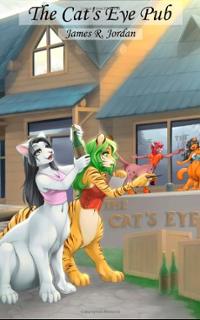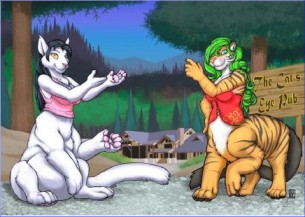Review: 'The Cat's Eye Pub', by James Robert Jordan

3 years after the events of Bound to Play, chakats Midsnow, Blacktail, and their family have made the move and immigration to Chakona the self proclaimed home world for the chakat species.
With intentions of opening their own business they are unaware of the many obstacles and challenges they will face. All while Midsnow's troubled past atempts [sic.] to catch up to hir." (back-cover blurb)
CreateSpace, June 2013, trade paperback $19.95 (308 pages), Kindle $7.99. Illustrated.
The Cat's Eye Pub, like Bound to Play and the forthcoming A Chakat in the Alley, is set (with permission) in Bernard Doove's Chakat Universe. It features those hermaphroditic centauroid felines, along with the humans, Caitians (bipedal felines), Rakshani (bipedal like Caitians but taller and more tigerlike), skunktaurs, and other species of Doove's 24th-century interstellar civilization.
Doove, a.k.a. Chakat Goldfur, has been writing chakat stories since 1995; has seven books of them including the Ursa Major Award-winning Life's Dream (2007) and Flight of the Star Phoenix (2012); and allows his friends to write their own stories in his Universe. To an extent, readers of The Cat's Eye Pub are expected to be familiar with the chakats and the 24th-century universe that they live in, but the background can be picked up fast. The only aspect that really needs getting used to is the hermaphroditic chakats', foxtaurs', and skunktaurs' unique pronouns, since neither "he" or "she" are appropriate: shi and hir. The single-gender species like the humans and Caitians still get to use "he" and "she".
Midsnow and Blacktail are the mothers of Midsun and Grill, the chakat teenagers who were the protagonists of Bound to Play. In that novel, the adults were in the background. In The Cat's Eye Pub they and especially Midsnow are the main characters. They have gotten married and Midsnow is about to become a mother again (remember, they're hermaphrodites). In 2349, they move with their cubs from Melbourne on Terra to Marpletown on Chakona. The story introduces several other young characters, seemingly at random, who will settle in Marpletown and gravitate to Midsnow's and Blacktail's new business: Shnu´rrárre (a.k.a. Whiskers), a Caitain who ran away from home to escape domineering parents; Starfield, a chakat orphan who was raised by Wolftaurs and grew up with a sometimes-embarrassing lupine body-language; Starpelt, a chakat searching for Midsnow's missing niece. They each make friends among the Marpletown inhabitants.

The Cat's Eye Pub is a human-interest melodrama, allowing for the fact that the only humans among the cast are very minor supporting characters. Firstly, the Marpletown Chief Justice who had previously indicated that there would be no trouble with opening the pub has died, and been replaced by a reactionary who not only refuses to approve a liquor license, shi tries to order the new building torn down. Secondly, Whiskers' parents have tracked her down and ordered her home, and her father has enough political power to make her life miserable if she refuses. Thirdly... well, all the friends, and their friends, unexpectedly start having a bad time all at once; some of it coincidentally and some not. Jordan does a good job of making it all seem believable.
This may seem like a common human-interest novel only with (mostly) chakats; but chakats being what they are, there is much casual and open sex between everybody almost all the time. Chakats are also empaths (and some are telekinetic), so a chakat can tell another chakat's real feelings toward them. Jordan, copying Doove, keeps it in good taste and makes it seem perfectly natural since the chakats are not human and are merely following their natures. Midsnow is so pregnant that shi waddles. And the chakats seem almost normal compared to other characters like the offworld college student Ian, whose parents were a skunktaur and a foxtaur (hyr pronouns are hy and hyr), and who undergoes involuntary sex changes. The hermaphrodites sometimes wonder whether they should act more masculine or more feminine, since they are both and can change personalities at will.
The group of chakats and a Caitain gradually work out their individual problems in the course of making a success together of Midsnow's and Blacktail's pub.
The novel does have one serious problem. All of the antagonists are so blatantly villainous that it is obvious to everyone else that they are clearly in the wrong, making the protagonists' victories virtually inevitable. A minor problem but an annoyance throughout the book is the apparent lack of any proofreading. I complained about this in my review of Bound to Play, but if anything, the errors are worse here. Punctuation is floating like "ceased ,and", or missing altogether. Dialogue is missing either the beginning or ending quotation mark. Words are missing or misused. "... a different was unfolding." (p. 9) A different what? "Immigration" in the blurb above should be "immigrated". Doove said in the comments to my Bound to Play review that the chakat word "chakker" should never be capitalized; it is capitalized here. There are common misspellings such as "to" for "too" and "use" for "used". It's a pity that such a basically good story is marred by so many easily corrected errors.
This book, like Doove's, has many illustrations; 25 by eleven different Fur Affinity artists, not counting the wraparound cover by Braulio Buendia Arrieta. The interior artwork, in black-&-white in the trade paperback, is in full color in the Kindle edition, making the Kindle edition the recommended choice. Recommended? Yes; despite the book's problems, The Cat's Eye Pub is a feel-good story featuring charismatic non-humans whose difference is more than window-dressing. I enjoyed it; I think that you will, too.
About the author
Fred Patten — read stories — contact (login required)a retired former librarian from North Hollywood, California, interested in general anthropomorphics
Comments
As I said before, if a writer is too damn lazy to take the time to proofread their own work, I'm not going to waste my time or money reading it. There's nothing wrong with taking the time to go through every page and ironing out the problems. Publishers are also part of the problem. If a novel has a bunch of grammar errors: don't publish it. If the writer has a problem with it, tough.
In this case, the author is effectively the publisher. Amazon's CreateSpace handles printing and distribution through its online properties; it also offers vanity publishing services, like copyediting, but you don't have to buy them.
That makes it worse in my eyes, though in the eyes of the publisher it's probably a joy. Seeings as I've been thinking of using CreateSpace myself the last thing I would need is it to garner a reputation in the fandom as having not proofread items.
I do think furrys are very particular when it comes to the visual aesthetics of pieces. Writing, too, has a visual aesthetic. If the reader can't flow over your words and instead has to slosh trough the errors against the current, they could miss enjoyment in what you're saying on figuring out what you mean.
Obviously there are a lot of rules. Some that even I forget sometimes. Which is why you either hire a person who is very good at doing these things, go with a publisher that will do these things, or have a really good friend who will. If you plan to sell it, DO NOT just randomly ask someone to do it on the internet. Some random person may correct it, but they could also steal it and publish it themselves after correcting it. Long story short, there should be at least one other proofreading and copy-editing it.
Quite honestly, it sounds like the author is a good writer in that they have a good story in terms of content, it's a shame that the errors in the writing itself distract from that. That's not a bad position to be in for a writer. Being creative enough to come up with good content is something that really cannot be taught easily. Grammar and word usage is something someone can more easily improve upon, and as already mentioned, they can have someone else double check for them in the meanwhile.
When I was in high school, there was a student who wanted to become an author in the worst way, and you know the old joke. He dismissed spelling as unimportant, and as a result, everyone laughed so much at his spelling that I don't think anyone ever got into his stories to tell whether they were any good or not. One was a horror story about a Wolfman, only he spelled it as the "Waflman". I quipped, "The Waflman? What does he do; drown his victims in maple syrup?"
Jordan is not that bad, but as you say, he tells a basically good story that is constantly interrupted by obvious and easily-corrected spelling and typographic errors. The writing is smooth, he handles dialogue well, his use of grammar is fine; but the reader has to just grit his (or her) teeth and plow through the missing punctuation, the wrong tenses, and the misspellings. The story is worth it, but Roscoe! the errors would be so easy to correct!
There is nothing wrong with CreateSpace, except their policy of doing absolutely no corrections unless you pay them to. Otherwise, it's YOUR responsibility to do your own proofreading. Or have a friend, or a professional proofreader outside of CreateSpace check everything carefully for you. AND MAKE SURE THAT THE CORRECTIONS GET MADE! They usually do; CreateSpace is good about that. I often see a book that looks like it came from a regular, professional publisher, except that it has CreateSpace's name on it. Bernard Doove's books, for example. You can even create "your own publishing company" with its own name, city, and logo; and the only clue that it is really from CreateSpace is the "printing press" statement on the last page before the back cover. M. C. A. Hogarth's Stardancer Press and Studio MCAH is really CreateSpace. I don't know how much extra it may cost to do that. However, there have been two occasions -- only two in the several years that I have been reading CreateSpace's books -- when a book has many errors in it, and when I have complained, the author has replied that I obviously got the book printed from the original, uncorrected file; not the proofread and corrected file. The error was quickly fixed, and since CreateSpace usually prints individual copies as they are ordered, presumably only ten copies or less printed from the wrong file went out. Just don't order 20 or 30 copies yourself to send to your whole family and all your friends before you are sure that all of the corrections are really in the book.
And, of course, you will usually want to get your own cover. CreateSpace will do it if you pay them to, but Furry fans have access to so many fine artists who take commissions! You can have your own cover tailored to your taste by one of your favorite Furry artists, and turn it over to CreateSpace yourself.
That is one reason that it is better to sell your book to a regular publisher if you can. The publisher will pay you -- maybe not much, but it is better than paying for everything yourself -- and (theoretically) do the basic copyediting and proofreading and professional cover art for you. If you fail to find a publisher, then you can go to CreateSpace as a last, rather than a first, resort.
Fred Patten
Post new comment